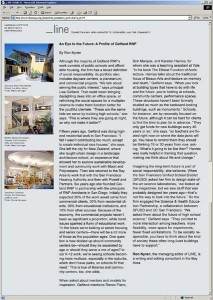 By Ron Nyren
By Ron Nyren
Although the majority of Gelfand RNP’s work consists of public schools and affordable housing, the firm has a broad definition of social responsibility; its portfolio also includes daycare centers, a planetarium, and commercial projects. “We talk about serving the public interest,” says principal Lisa Gelfand. That could mean bringing daylighting deep into an office space, or rethinking the social spaces for a multiplex cinema to make them function better for the youthful clientele. “These are the same kids we serve by building high schools,” she says. “This is where they are going at night, so why not make it better?”
Fifteen years ago, Gelfand was doing high-end residential work in San Francisco. “I felt I wasn’t contributing too much, except to create individual nice houses,” she says. She left the city for New Zealand, where she taught urban design in a landscape architecture school, an experience that allowed her to explore sustainable development and community work with Maori and Polynesians. Then she returned to the Bay Area to work first with the San Francisco Housing Authority and then with Powell and Partners. Six years ago she founded Gelfand RNP in partnership with the principals of RNP Architects in San Diego. Initially they expected 30% of the work would come from commercial clients, 30% from residential clients, 30% from educational institutions, and 10% from other sources. Because of the economy, the commercial projects haven’t been as significant a proportion, while bond issues sparked a flurry of educational work. “In the future we’re looking at senior housing and senior centers—there will be a lot more of those as the population ages. One question is how divided up should community centers be—should they be separated by age or should they serve a mix of ages? In our K-12 work, we’re seeing schools becoming more multiuse, especially in the suburbs, which don’t have parks, so schools fill that need.” This is true of libraries and community centers, too, she adds.
When asked about mentors and models for inspiration, Gelfand mentions Renzo Piano, Bob Marquis, and Karsten Harries, for whom she was a teaching assistant at Yale. “In his book The Ethical Function of Architecture, Harries talks about the traditional focus of Beaux-Arts architecture on memory and death,” Gelfand says. “When you look at building types that have to do with life and the future, you’re looking at schools, community centers, performance spaces. These structures haven’t been formally studied as much as the backward-looking buildings, such as monuments.” Schools, for instance, are by necessity focused on the future, although it can be hard for clients to find the time to plan far in advance. “They only get funds for new buildings every 40 years or so,” she says, “so teachers are fixated right now on where the data jacks will go. You have to remind them they should be thinking 10 or 30 years from now, asking, ‘What’s it going to be like then?’ Harries was really helpful in framing that question, making me think about life and change.”
Imagining the long-term future is part of social responsibility, she believes. When the San Francisco Unified School District (SFUSD) asked her firm to design state-of-the-art science laboratories, “we looked at the magazines, but we saw stuff that was probably designed ten years ago—that’s not the way to look into the future.” So the firm engaged the Science & Health Education Partnership, a collaboration between SFUSD and UC San Francisco. “We asked them about the future of high school science,” Gelfand says. “They pointed to more interaction among teachers, more flexibility, more space for experiments, fewer fixed workstations. To be socially responsible, you have to think about the kind of society these often long-lived buildings have to support.”
Ron Nyren, the managing editor of LINE, is a writing and editing consultant in the Bay Area